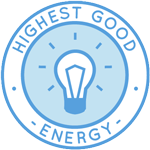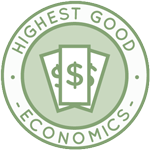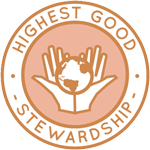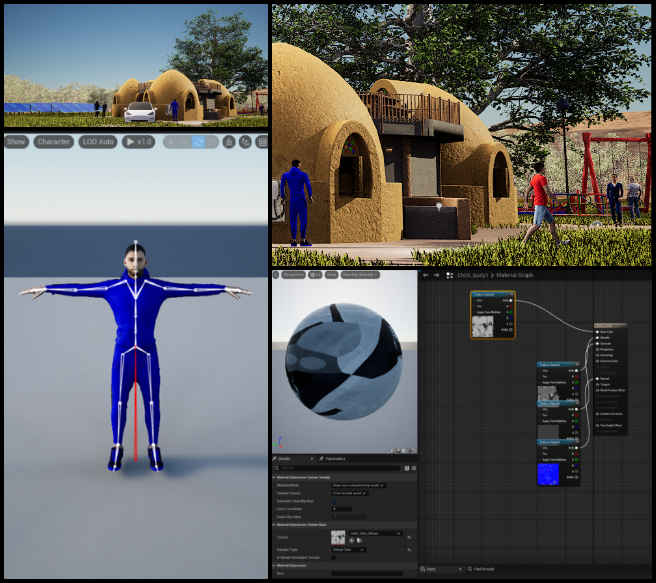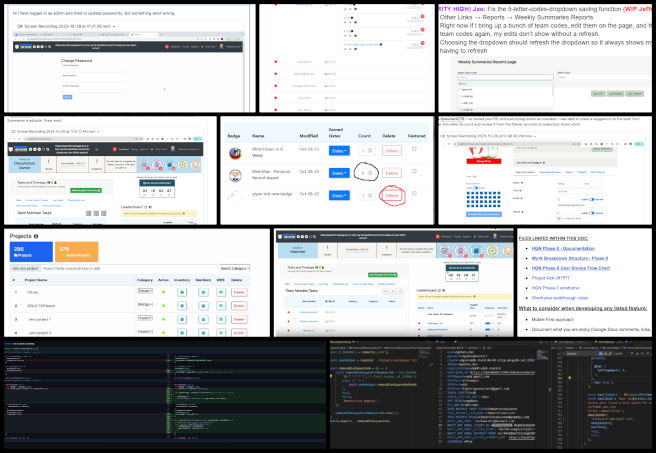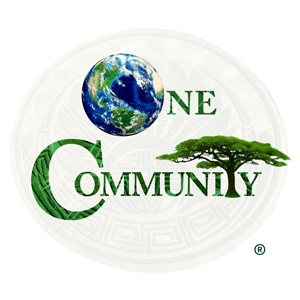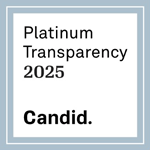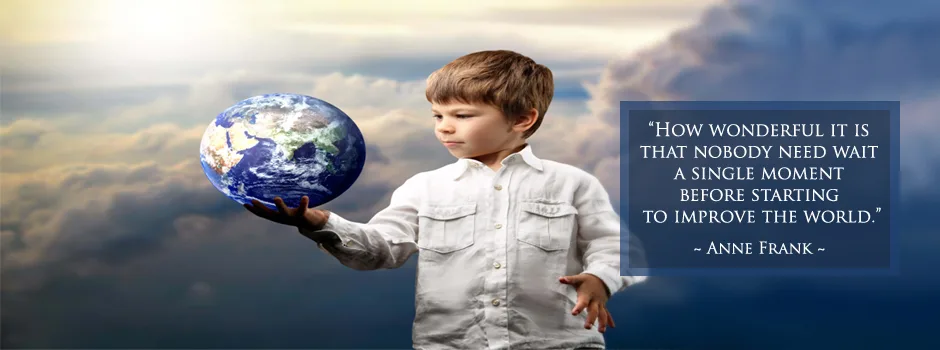
One Community Welcomes Yeasin Arafat to the Design Team!
Posted on October 31, 2023 by One Community Hs
One Community welcomes Yeasin Arafat to the Graphic Design Team as our newest Volunteer/Consultant!

Yeasin has a profound enthusiasm for creating sustainable and innovative solutions that shape our built environment. An aspiring engineer with a strong foundation in structural analysis, sustainable design, and environmental sustainability, Yeasin is pursuing a bachelor’s degree in Civil Engineering at Zhengzhou University. He has gained hands-on experience through internships and practical projects, enhancing his project management skills and problem-solving abilities. As a member of the One Community team, Yeasin has helped with designing the social media content for the One Community weekly progress updates.
WELCOME TO THE TEAM YEASIN!
FOLLOW ONE COMMUNITY’S PROGRESS (click icons for our pages)
INVESTOR PAGES
GET INVOLVED
One Community Welcomes Sarah Boyd to the Design Team!
Posted on October 31, 2023 by One Community Hs
One Community welcomes Sarah Boyd to the Engineering Team as our newest Volunteer/Consultant!
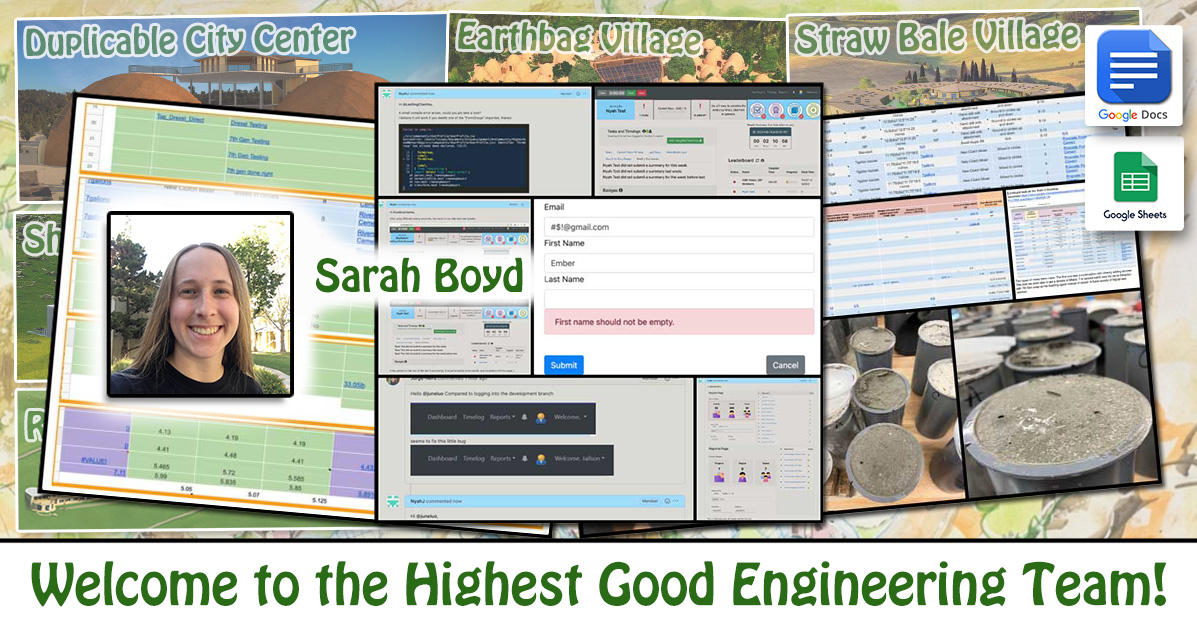
Sarah is a student at California Baptist University (CBU) studying Civil Engineering. She chose Civil Engineering for two reasons. The first reason is her love for national parks. She has visited many throughout the United States and has learned that the world needs to be protected, and its resources used wisely. Her second experience took place during a mission trip to Ensenada, Mexico. While there, she participated in building a house and a school. This experience showed her the importance of construction and how it can be a blessing to people. With her degree, Sarah hopes to pursue a career related to water resources and management. As a member of the One Community team, Sarah helped with the planning, documentation, and problem solving for the 2nd round of aircrete compression testing for the open source Aircrete Engineering and Research: Compression Testing, Mix Ratios, R-value, and More page.
WELCOME TO THE TEAM SARAH!
FOLLOW ONE COMMUNITY’S PROGRESS (click icons for our pages)
INVESTOR PAGES
GET INVOLVED
One Community Welcomes Xiao Fei to the Software Development Team!
Posted on October 31, 2023 by One Community Hs
One Community welcomes Xiao Fei to the Software Development Team as our newest Volunteer/Consultant!

Xiao attended the University of Wisconsin-Madison, where he earned a Bachelor of Science in Computer Science and Mathematics. He is proficient in a wide range of languages and frameworks including React, Gatsby, Svelte, Django, Spring Boot, GraphQL, React Native, Swift, and Kotlin. In addition, he holds an AWS Certified Solution Architect credential. During Xiao’s senior year’s capstone project, he led the front-end team in collaboration with Amazon Inc’s Shopbop, pioneering an innovative web application that elevated the online shopping experience. Xiao’s expertise also encompasses cross-platform and native mobile application development, exemplified by a cross-platform application integrated with AWS infrastructure. As an active member of One Community, Xiao contributes to the Open Source Software ” Highest Good Network, prioritizing user interface enhancement and back-end optimization.
WELCOME TO THE TEAM XIAO!
FOLLOW ONE COMMUNITY’S PROGRESS (click icons for our pages)
INVESTOR PAGES
GET INVOLVED
Cooperatively Designing a World that Works for Everyone – One Community Weekly Progress Update #554
Posted on October 30, 2023 by One Community
Cooperatively designing a world that works for everyone is about fostering collaborative efforts that lead to sustainable solutions across various domains such as food, energy, housing, education, and social architecture. Our approach focuses on collective design and implementation, ensuring that every step we take is geared towards creating a world where all individuals thrive. What truly distinguishes One Community is our commitment to open sharing, making our entire process accessible to everyone, and facilitating a global movement towards a more inclusive and equitable future.
- Here’s our project overview
- Here’s our world-change methodology
- Here’s how this becomes self-replicating
- Here’s how we are open source and free-sharing all the do-it-yourself designs

OUR MAIN OPEN SOURCE HUBS
Click on each icon to be taken to the corresponding Highest Good hub page.
One Community’s physical location will forward this movement as the first of many self-replicating teacher/demonstration communities, villages, and cities to be built around the world. This is the October 30th, 2023 edition (#554) of our weekly progress update detailing our team’s development and accomplishments:
Cooperatively Designing a World
that Works for Everyone
One Community Progress Update #554
DONATE | COLLABORATE | HELP WITH LARGE-SCALE FUNDING
CLICK HERE IF YOU’D LIKE TO RECEIVE AN EMAIL EACH WEEK WHEN WE RELEASE A NEW UPDATE
YOU CAN ALSO JOIN US THROUGH SOCIAL MEDIA
ONE COMMUNITY WEEKLY UPDATE DETAILS
COOPERATIVELY DESIGNING A WORLD THAT WORKS FOR EVERYONE – HIGHEST GOOD HOUSING PROGRESS
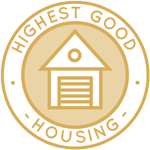 One Community is cooperatively designing a world that works for everyone through Highest Good housing that is artistic and beautiful, more affordable, more space efficient, lasts longer, DIY buildable, and constructed with healthy and sustainable materials:
One Community is cooperatively designing a world that works for everyone through Highest Good housing that is artistic and beautiful, more affordable, more space efficient, lasts longer, DIY buildable, and constructed with healthy and sustainable materials:
- Learn about: Our Upcoming Crowdfunding Campaign
- Learn about the different village models: 7 Sustainable Village Models
- Visit the open source portals for the first two: Earthbag Village OS Hub | Straw Bale Village OS Hub
This week, the core team continued the review of the Murphy Bed assembly instruction PDF document. We corrected comments related to blurry linked PDF documents, reviewed the Wall Section for lumber lists, cuts layout, and sizes against the 3D SketchUp model, commented on the missing width dimension for the wall part’s opening, reviewed the entire “Benches and Table” section, checked the updated lumber layout in the SketchUp model for the “Clothing & Storage” section, generated an image with all measurements for the upper shelving unit and added comments about the correct dimensions. The review extended up to page 106 of the “Murphy Bed assemble instruction PDF document.” See below for a collage of some of this work.
Yiwei He (Mechanical Engineer) continued assisting with the Vermiculture Toilet designs. Yiwei continued her review of the CAD model for the vermiculture container structure and subsequently organized a meeting with the team to discuss the next steps.
She also met with the Duplicable City Center group to assess progress made, and researched finite element analysis (FEA) simulations for earthquake scenarios. See the pictures below.
Vidhi Bansal (3D Visualization Artist) completed another week of assisting with Earthbag Village. This week, Vidhi, worked on the 4 dome flythrough. She resized characters, paying careful attention to accurate scaling and double checking the measurements with the drawings provided.
Additionally, the week saw efforts invested in refining animation quality and clothing quality, a process that encompassed control rig adjustments and comprehensive retouching for every character. She refined the animations and added more people. Vidhi also worked on test render output throughout the week which is being used to constantly test whether the animations are continuous and consistent.
See below for some of the pictures.
COOPERATIVELY DESIGNING A WORLD THAT WORKS FOR EVERYONE – DUPLICABLE CITY CENTER PROGRESS
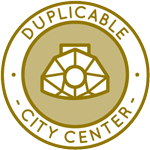 One Community is cooperatively designing a world that works for everyone through a Duplicable and Sustainable City Center that is LEED Platinum certified/Sustainable, can feed 200 people at a time, provide laundry for over 300 people, is beautiful, spacious, and saves resources, money, and space:
One Community is cooperatively designing a world that works for everyone through a Duplicable and Sustainable City Center that is LEED Platinum certified/Sustainable, can feed 200 people at a time, provide laundry for over 300 people, is beautiful, spacious, and saves resources, money, and space:
- Learn about this building and it’s function: Duplicable City Center Open Source Hub
This week, Amiti Singh (Architectural Designer) continued her work helping with the interior design details for the rental rooms within the Duplicable City Center. Amiti completed the development of the Japanese tea room-themed visitor room, incorporating recommended adjustments to the 3D visual representation and drawing inspiration from traditional Japanese tea room ambiance.
She carried out post-processing on the room renders and produced a comprehensive mood board encompassing material selection, furniture design, color coordination, and paint palette curation through slides. Additionally, Amiti concluded the furniture and material selection process, resulting in a thorough cost analysis of the room.
She also explored new themes for room design within the Duplicable City Center. See below for the collage of images related to this.
Justin Varghese (Mechanical Engineer) completed another week assisting with the City Center Dome Hub Connector Engineering. Justin’s primary focus has been on conducting a comprehensive stress analysis that encompasses the entire dome structure, including its beams and newly designed hub connectors.
Within this scope, his activities have entailed defining contact types, such as bonded or separation contact, applying appropriate forces, establishing necessary constraints, and making informed choices regarding meshing scales. At present, Justin is working on the ongoing finite element analysis (FEA) simulation for the dome, furthering the understanding of its structural integrity. See some of the images below.
COOPERATIVELY DESIGNING A WORLD THAT WORKS FOR EVERYONE – ENGINEERING TEAM
This week, the engineering summary was managed by Arvindh Xavier (Civil Engineer) and featured Julio Marín Bustillos (Mechanical Engineer) highlighting Julio’s completion of the design work for hub connectors in the third, fourth, and top (ninth) rows. As his focus shifts he will begin integrating the newly designed Dome Hub Connector into the overall structure.
Julio will also begin conducting stress simulations across the entire structure, ensuring alignment with the project’s requirements and objectives, as he continues to make progress in this area. See the pictures below.
COOPERATIVELY DESIGNING A WORLD THAT WORKS FOR EVERYONE – HIGHEST GOOD FOOD PROGRESS
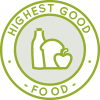 One Community is cooperatively designing a world that works for everyone through Highest Good food that is more diverse, more nutritious, locally grown and sustainable, and part of our open source botanical garden model to support and share bio-diversity:
One Community is cooperatively designing a world that works for everyone through Highest Good food that is more diverse, more nutritious, locally grown and sustainable, and part of our open source botanical garden model to support and share bio-diversity:
- Learn about the structures: Hoop House Hub | Aquapini & Walipini Open Source Hub
- See what we’ll be growing: Gardens & Hoop Houses | Large-scale Structures | Food Forest | TA
This week, Hayley Rosario (Sustainability Research Assistant) continued her review of the open-source Highest Good Food designs. She reviewed materials and task lists, concurrently addressing the format of the existing webpage. She researched unfamiliar topics, formulating a list of questions for a discussion meeting with a member of our core team.
Additionally, she provided links to the organized material task lists in her session summaries. See below for the images.
Smit Bhoir (Data and Business Analyst) started data tasks for the Kitchen Recipe, completed the Transition kitchen recipe menu cell referencing task for all the tabs linking them to MasterRecipe, and began cost analysis and other data related tasks assigned for the kitchen menu spreadsheet.
He also attended weekly meetings with Harsha to improve Google Adwords user engagement and reviewed the Software PR review team’s work. See the collage below to view this work.
COOPERATIVELY DESIGNING A WORLD THAT WORKS FOR EVERYONE – MENUS UI/UX WEB AND GRAPHICS TEAM
This week, the Transition Food Self-sufficiency Plan UI/UX Web and Graphics development was managed by Shivangi Patel (Graphic Designer), combining her work with the contributions of Rihab Baklouti (Freelance Generalist). Together they created finalized mock-up designs for what will be a new Open Source Menu web homepage.
This collaborative process involved the exchange of feedback and revisions to ensure a polished final UI/UX product. See below for the images.
COOPERATIVELY DESIGNING A WORLD THAT WORKS FOR EVERYONE – HIGHEST GOOD EDUCATION PROGRESS
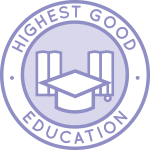 One Community is cooperatively designing a world that works for everyone through Highest Good education that is for all ages, applicable in any environment, adaptable to individual needs, far exceeds traditional education standards, and more fun for both the teachers and the students.
One Community is cooperatively designing a world that works for everyone through Highest Good education that is for all ages, applicable in any environment, adaptable to individual needs, far exceeds traditional education standards, and more fun for both the teachers and the students.
This component of One Community is about 95% complete with only the Open Source School Licensing and Ultimate Classroom construction and assembly details remaining to be finished. We’ll report on the final two elements to be finished as we develop them.
With over 8 years of work invested in the process, the sections below are all complete until we move onto the property and continue the development and open sourcing process with teachers and students – a development process that is built directly into the structure of the education program and everything else we’re creating too:
- Program Overview: Education Open Source Hub
- How the components work together: How to use the Education for Life Program
- Lesson Plans for Life – Lesson Plans How-to
- Foundations of Outstanding Leaders, Teachers, and Communicators
- Curriculum for Life
- Teaching Strategies for Life
- Learning Tools and Toys for Life
- Evaluation and Evolution
COOPERATIVELY DESIGNING A WORLD THAT WORKS FOR EVERYONE – HIGHEST GOOD SOCIETY PROGRESS
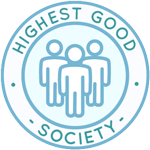 One Community is cooperatively designing a world that works for everyone through a Highest Good society approach to living that is founded on fulfilled living, the study of meeting human needs, Community, and making a difference in the world:
One Community is cooperatively designing a world that works for everyone through a Highest Good society approach to living that is founded on fulfilled living, the study of meeting human needs, Community, and making a difference in the world:
- Read the Highest Good society overview: Highest Good Society
- Learn about the model for fulfilled living and sharing: A Day in the Life
- Learn about the 4 economic models: RBE | For-profit | Non-profit | Entrepreneurship
- Learn about our open source community collaboration and management software: The Highest Good Network
This week, the core team completed 52 hours managing One Community volunteer-work review not included above, emails, social media accounts, web development, new bug identification and bug-fix integration for the Highest Good Network software, and interviewing and getting set up new volunteer team members. The pictures below show some of this work.
Another core team member contributed this week by continuing to review Eckart Tolle’s audio recording “A New Earth”, including various thoughts that were then transcribed onto a separate Google doc. These quotes may be included in an upcoming update to the One Community website. View some of this work in the collage below.
Harsha Kulkarni (Data Analyst) continued working on One Community’s Google AdWords campaigns and Analytics details. This week, Harsha focused on comprehending Looker reports generated from Google Analytics. She took time to understand the current pipeline and dashboard setup and began migrating these reports to align with the Google Analytics 4 data source.
Simultaneously, Harsha addressed ad campaign optimization, concentrating on enhancing the ad strength of specific ads within the Food ad campaign. Her efforts resulted in achieving an average ad strength level for the Apiary and Dam ad groups. The image below shows some of this work.
Jin Hua (Website, AdWords, and Analytics Administrator) helped answer questions for the Analytics team and began setting us up to redeploy Cloudflare now that we’ve got Nitropack working properly. See below for images related to this.
Vishvesh Sheora (Artificial Intelligence Specialist) focused on elevating the SEO performance of a multitude of blog posts featured on the One Community website. This week, Vishvesh partitioned the ‘About Us’ page from the ‘Global Sustainability Systems’ page, ensuring both attained exceptional SEO scores surpassing 90.
In addition, he elevated the SEO score of the ‘Weekly Progress Update #539’ blog post to achieve a better SEO score over 80, aligning with the standards set by the RankMath SEO plugin. See the work in the image below.
COOPERATIVELY DESIGNING A WORLD THAT WORKS FOR EVERYONE – ADMINISTRATION TEAM
This week, the Administration Team’s summary, covering their work administrating and managing most of One Community, was managed by Jamie Cruz (Administrative Assistant, Social Media Manager, and Team Manager) and includes Alyx Parr (Senior Support Specialist), Olawunmi “Ola” Ijisesan (Administrative and Management Support), Ruiqi Liu (Administrative Assistant), Shaurya Sareen (Administrative Assistant), and Xiaolai Li (Administrative Assistant).
Alyx worked on various tasks related to the blog, editing and adding team summaries, fixing page summaries, copying content, downloading images, and providing feedback. She completed her contributions, followed up with team members, and initiated her part of the blog.
Jamie contributed to multiple teams, including the Core Team, the Administration Team, Blue Steel, and individual collaborators, creating summaries, and collages, and proofreading. She also improved a training tutorial for incoming volunteers and began the set up process so she can post on social media as an administrator for One Community.
Ola created summaries, images, picture collages, and SEO optimizations for the weekly blog, managing tasks for non-HGN team members, and providing reviews and feedback on PR team projects. Ruiqi focused on reviews and feedback for various teams, including the Funding Team, Git-R-Done Team, Graphic Design Team, and Expresser Team.
She created collages, handled SEO keyword integration on WordPress, and revised the weekly progress update webpage. Shaurya worked on reviews of pull requests, ensuring team members followed the necessary steps and updating tracking sheets and tables to ensure compliance with minimum PRs and hours.
He compiled a concise team summary and created collages featuring all PRs. Finally, Xiaolai oversaw the team’s progress, fixed errors in the weekly report draft, organized documents and comments, reviewed the business plan and cost analysis tables, and collected summaries, images, and videos of team members’ work for the week. The collage below shows some of this work.
COOPERATIVELY DESIGNING A WORLD THAT WORKS FOR EVERYONE – BLUE STEEL SOFTWARE DEVELOPMENT TEAM
This week, the Blue Steel Team’s summary, covering their work on the Highest Good Network software, was managed by Nathan Hoffman (Software Engineer and Team Manager) and includes Haohui Lin (Software Engineer), Xiao Wang (Software Engineer), and Yongjian Pan (React.js/MongoDB Full Stack Software Developer).
Xiao worked on addressing feedback for the recently launched timer feature, improving user experience by allowing goal time customization and adding tooltips to timer buttons.
Nathan was actively involved in reviewing team summaries and videos, reorganizing the permissions spreadsheet to incorporate categories and multi-checkboxes, and focusing on the cascading indenting functionality in the new permissions component. Haohui familiarized himself with app features and conducted PR reviews, including tasks related to fixing permissions for editing tasks.
Yongjian eliminated unused React hooks in PR #1331 to resolve console log errors, aligned the user management page with display requirements, and implemented permissions for deletion, with an ongoing commitment to resolve a failed npm test blocking a PR merge. The collage below shows some of this work.
COOPERATIVELY DESIGNING A WORLD THAT WORKS FOR EVERYONE – EXPRESSERS SOFTWARE DEVELOPMENT TEAM
This week, the Expressers Team’s summary, covering their work on the Highest Good Network software, was managed by Tim Kent (Full Stack Software Engineer) and includes Aaron Persaud (Software Developer), Aishwarya Kalkundrikar (Full Stack Software Developer), Olga Yudkin (Software Engineer), Tianyuan Nan (Software Engineer), Vishala Ramasamy (Software Developer) and Yuri Clemente Andrade Sokolovicz (Software Engineer and Team Manager).
Vishala created a pull request (PR) for the log materials task and implemented a pop-up window feature on the materials list page. Yuri focused on the final styling of the toolEquipmentList component and began backend development options. Tianyuan completed three PR reviews, addressed a console warning issue, and worked on the assigned bug regarding email list visibility.
Olga fixed unit tests for the FoundUser component, refactored the BM dashboard component, and reviewed PR1447. Aaron worked on troubleshooting issues and resolving lint fixes, and assisted colleagues with debugging.
Tim worked on developing ideas and processes for the Phase 2 Building Management Dashboard project, hosted the standup meeting, and began reorganizing the Add Materials code. Aishwarya reviewed Tim’s PR files to gain insights into the relationship between frontend and backend components.
She held discussions with Jae to establish the framework for Phase 2 collections and, per their agreement, created a new collection. The collage below shows some of this work.
COOPERATIVELY DESIGNING A WORLD THAT WORKS FOR EVERYONE – FUNDING TEAM
This week, the Funding Team’s summary, covering their work for One Community Funding, was managed by Aaron Wang (Fundraising Assistant). Aaron completed follow-up email communication with six donors who had previous connections, aiming to advance ongoing communication.
He also initiated email contact with seven potential donors, expressing a desire to establish connections. Additionally, he did research on five additional potential funders, involving an assessment of their backgrounds, philosophy, funding track records, potential for securing funds, and the acquisition of their contact information. The collage below shows some of his work.
COOPERATIVELY DESIGNING A WORLD THAT WORKS FOR EVERYONE – GIT-R-DONE SOFTWARE DEVELOPMENT TEAM
This week, the Git-R-Done Team’s summary, covering their work on the Highest Good Network software, was managed by Ruiqi (Administrative Assistant) and includes Eduardo Horta (Software Engineer), Jeffrey Li (Full-Stack Software Developer), Kaikane Lacno (Learning Assistant), Miguelcloid Reniva (Software Developer), Olena Danykh (Software Engineer), Ziming Song (Software Engineer).
Eduardo focused on documentation for HGN Phase II, team orientation, and hotfixing the email batch generator. He reviewed and approved various contributions and assisted in addressing permissions issues while providing feedback to team members.
Jeffrey addressed a development bug related to the 5-letter-codes-dropdown saving function within the Weekly Summaries Report, adapting his approach and ultimately resolving the bug. Kai participated in pull reviews, bug identification, and enhancements to improve dashboard load speed, contributing to smoother task management.
Miguelcloid reviewed documentation, provided input on bug reproduction, and worked on addressing badge-related issues. Olena dedicated her time to scrutinizing documentation, conducting PR reviews, and gaining a deeper understanding of the permission component.
Ziming joined the development team and completed seven pull requests, engaging in discussions with PR authors and ensuring thorough testing. The collage below shows some of this work.
COOPERATIVELY DESIGNING A WORLD THAT WORKS FOR EVERYONE – GRAPHIC DESIGN TEAM
This week, the Graphic Design Team’s summary was managed by Ruiqi (Administrative Assistant) and includes Nancy Mónchez (Graphic Designer), Rihab Baklouti (Freelance Generalist), and Shivangi Patel (Graphic Designer). Ashlesha created two Volunteer Announcements with bio and announcement images and web content, alongside five Social Media Images.
She also did research and curation for nature-based and theme-based images. Rihab focused on the Food Transition Menu webpage, completing the mock-up design for the home page screen. Nancy created some additional redesigned posts. She used various fonts and a consistent color palette further enhancing uniformity.
Shivangi cooperated with Rihab to contribute to developing finalized mock-up designs for the Open Source Menu web homepage. She exchanged feedback with Rihab and modified the design of earlier versions to ensure the quality of the final UI/UX product. The collage below shows some of this work.
COOPERATIVELY DESIGNING A WORLD THAT WORKS FOR EVERYONE – MOONFALL’S SOFTWARE DEVELOPMENT TEAM
This week, Moonfall Team’s summary, covering their work on the Highest Good Network software, was managed by Navneeth Krishna (Software Engineer) and includes Anny Wang (Software Engineer), Cheng-Yun Chuang (Software Engineer), Haoji Bian (Software Engineer), Jiadong Zhang (Volunteer Software Engineer), Ruike Qiu (Software Engineer), Tzu Ning “Leo” Chueh (Software Engineer), Xiao Fei (Software Engineer), Yihan Liu (Software Engineer), YuFu Liao (Software Engineer), Zijie “Cyril” Yu (Volunteer Software Engineer) and Zubing Guo (Software Engineer).
Anny implemented fixes to improve the loading speed of the team name section, developed methods for data retrieval and reviewed previous PR submissions. Cheng-Yun reviewed a significant number of pull requests on both the HGNRest backend and HighestGoodNetworkApp frontend, with notable focus on frontend pull requests.
Haoji implemented an automated system and developed the enhanced admin interface. Jiadong replicated a bug affecting conversion of intangible timelogs and corrected it by refreshing the current page.
Navneeth focused on resolving testing issues related to “Permissions Mngmnt: See Teams Management Tab” and contributed to various pull requests on the frontend and backend. As Team Manager of Team Moonfall, he undertook tasks including daily monitoring, weekly work reviews, task assignments, and weekly summary preparation.
Ruike reviewed two pull requests focused on unit testing and also dealt with a bug associated with white spaces in filenames, fixing it through a Python script and a new rule in gitignore. Tzu Ning reviewed and approved several pull requests. Xiao F completed a pull request that dealt with implementing ‘suggested’ changes on tasks and also identified issues with default permissions for managers in the backend.
Yihan manually added lost hours for past years of volunteers. She worked on functionalities such as the ‘Add Lost Time’ form and the lost time history modal. Yufu helped enable owners to edit certain columns on the user management page, working closely with Jae to implement the feature correctly.
Zijie worked on suggestions made on his GitHub pull requests, thereby completing important tasks and submitting new pull requests for review. Finally, Zubing integrated the ‘Write it for me’ button into the summary page, even redesigning the frontend code to optimize the button’s functionalities. Look below for a collage of their work.
COOPERATIVELY DESIGNING A WORLD THAT WORKS FOR EVERYONE – REACTONAUTS’ SOFTWARE DEVELOPMENT TEAM
This week, Reactonauts’ Team’s summary, covering their work on the Highest Good Network software, was managed by Carl Bebl (Software Developer) and includes Anirudh Ghildiyal (Software Engineer), Jiangwei Shi (Full Stack Engineer), Jiyuan Xia (Software Engineer), Masasa Thapelo (Software Engineer), Obeda Velonjatovo (Front End Developer/Software Developer), Shantanu Kumar (Full Stack Software Developer), Shihao Xiong (Software Engineer), Shivansh Sharma (Software Developer), Shiwani Rajagopalan (Software Engineer), Shrey Jain (Software Engineer), Shubhankar Mishra (Software Engineer), Wanting Xu (Software Engineer) and Yixiao Jiang (Software Engineer).
Wanting addressed the issue identified in PR 1434, specifically the inability for an admin to save an edited 5-letter team code, and also worked on “X hours in X weeks” streak badges and PR reviews for #1442, #1445, #1460, and #1461.
Shiwani set permissions for ‘totalValidWeeklySummaries,’ resolved a persistence issue with administrator permissions, submitted PRs #1459 and #588, and worked on unit tests for ‘TeamMemberTask.jsx’. Carl improved the suggestion email for user feedback, hold meetings with team members, and actively participated in PR reviews for issues #1435, #1438, #1439, #1442, #1443, #1445, and #1460.
Anirudh resolved the edit button issue, implemented permission checks, and addressed a bug affecting user display on the manager’s dashboard. Shihao reviewed and approved PRs #1454 and #1461, provided assistance on PR #1453, and optimized group member addition and sorting logic. Shrey wrote unit test cases for Member.jsx, identified and fixed an error, and submitted PR#1465.
Masasa focused on peer review modifications, managing merge conflicts and aligning permission descriptions for precision and completeness. Jiawei contributed to project robustness by developing tests for the TeamEntriesViz module and shared them transparently on GitHub for collaboration. Obeda focused on addressing a lint fix and identified the cause of the failing tests.
Shantanu improved the efficiency of the “Submit for Review” button by implementing the several changes in the code. Shivansh investigated the current Node.js version running on Azure servers, determining that it operates on the latest LTS version.
Additionally, he took on the task of creating a new admin user within the Azure environment, ensuring that the original account owner need not share their credentials with other team members. Shubhankar carried out reviews for 6 specific PRs, namely #1460, #1450, #1451, #1454, #1461, and #1464, evaluating each while taking into account past feedback and modifications.
Yixiao identified and rectified a comment error made during the testing process. Additionally, she submitted a pull request for the Checkbox.test.js file in the GitHub repository, including the composition of unit tests. Look below for pictures of this work.
COOPERATIVELY DESIGNING A WORLD THAT WORKS FOR EVERYONE – SKYE’S SOFTWARE DEVELOPMENT TEAM
This week, Skye’s summary, covering their work on the Highest Good Network software, was managed by Luis Arevalo (Front End Developer) and includes Bailey Mejia (Software Engineer), Fan Yang (Software Engineer), Hector Agudelo-Carmona (Front-End Developer), Jerry Ren (Full Stack Developer) and Yao Wang (Software Engineer).
Bailey initiated discussions on the ongoing personal max badge error and facilitated the team meeting with Luis, focusing on identifying team competencies. He theorized the badge error might be due to prerequisites, prompting further testing and debugging.
Luis resolved immediate user profile updates, identifying cache-related issues. Jerry completed the “Create Dev Admin account email verification system” task, published Pull Requests, and collaborated with Xiao W on a hotfix for the Reports page. Jerry focused on a Badge component bug and investigated issues with project display delays on user profiles alongside Luis.
Yao led the team in fixing the “submit for review” button bug and ran thorough testing to identify the next assignment. Hector, after a two-week absence, reacquainted himself with prior tasks, focusing on the location modal feature and fixing the Ukrainian location bug.
Hector endeavored to adapt the modal to the location error feature, eventually deciding to create a new modal using ReactJS-pop-up due to potential impact on application parts. Fan looked into an error with the “submit for review” button on the dashboard and reviewed three PRs in the frontend code. See the collage below for their work.
COOPERATIVELY DESIGNING A WORLD THAT WORKS FOR EVERYONE – SOFTWARE PR REVIEW TEAM
The PR Review Team’s summary covering their work on the Highest Good Network software, was managed by Shaurya Sareen (Administrative Assistant).
This week’s active members of this team were: Anish Pandita (Software Engineer), Chirayu Rai (Software Engineer), Jahanzaib Malik (Software Engineer), John Ifeanyi Omeokwe (Software Engineer), Kavya Alla (Software Engineer), Mohit Bali (Software Engineer), Mike ” Munkh Erdene Erdenebulgan (Full Stack Developer), Palak Gosalia (Software Engineer), Savio Mendes (Software Engineer), and Yi Lin (Software Engineer).
They reviewed all the Highest Good Network PRs (Pull Requests) shared in this week’s update. The collage below shows a compilation of the work from this team.
AND WE PRODUCED THIS WEEKLY UPDATES BLOG – CLICK HERE TO SUBSCRIBE
FOLLOW ONE COMMUNITY’S PROGRESS (click icons for our pages)
INVESTOR PAGES
GET INVOLVED
One Community Welcomes Roberto Contreras to the Software Development Team!
Posted on October 25, 2023 by One Community Hs
One Community welcomes Roberto Contreras to the Software Development Team as our newest Volunteer/Consultant!

Roberto Contreras, a growing software developer who prides himself in adaptability and coachability, excels in dynamic environments and collaborating with diverse teams. Roberto had work experience in the food industry, working his way up to become a sous chef, before undergoing a career transition that led him to graduate from General Assembly’s software engineering immersive program. This journey has helped him improve his skills and advance as a developer. During his time at One Community, he has demonstrated his expertise in identifying and resolving critical bugs in both the frontend and backend repositories, significantly improving overall system functionality of the open-source Highest Good Network software.
WELCOME TO THE TEAM ROBERTO!
FOLLOW ONE COMMUNITY’S PROGRESS (click icons for our pages)
INVESTOR PAGES
GET INVOLVED
Maximizing Sustainable Impact – One Community Weekly Progress Update #553
Posted on October 23, 2023 by One Community
At One Community, our driving force is maximizing sustainable impact. We are achieving this by focusing on open source and free-shared sustainability across diverse areas like food, energy, housing, education, social architecture, fulfilled living, and more.
Our pioneering model is not just about making a difference; it’s about magnifying that difference globally through a collaboration of teacher/demonstration hubs working together for the the highest good of all people and life.
- Here’s our project overview
- Here’s our world-change methodology
- Here’s how this becomes self-replicating
- Here’s how we are open source and free-sharing all the do-it-yourself designs

Maximizing Sustainable Impact
OUR MAIN OPEN SOURCE HUBS
Click on each icon to be taken to the corresponding Highest Good hub page.
One Community’s physical location will forward the movement of maximizing sustainable impact as the first of many self-replicating teacher/demonstration communities, villages, and cities to be built around the world. This is the October 23rd, 2023 edition (#553) of our weekly progress update detailing our team’s development and accomplishments:
Maximizing Sustainable Impact
One Community Progress Update #553
DONATE | COLLABORATE | HELP WITH LARGE-SCALE FUNDING
CLICK HERE IF YOU’D LIKE TO RECEIVE AN EMAIL EACH WEEK WHEN WE RELEASE A NEW UPDATE
YOU CAN ALSO JOIN US THROUGH SOCIAL MEDIA
ONE COMMUNITY WEEKLY UPDATE DETAILS
MAXIMIZING SUSTAINABLE IMPACT – HIGHEST GOOD HOUSING PROGRESS
 One Community is maximizing sustainable impact through Highest Good housing that is artistic and beautiful, more affordable, more space efficient, lasts longer, DIY buildable, and constructed with healthy and sustainable materials:
One Community is maximizing sustainable impact through Highest Good housing that is artistic and beautiful, more affordable, more space efficient, lasts longer, DIY buildable, and constructed with healthy and sustainable materials:
- Learn about: Our Upcoming Crowdfunding Campaign
- Learn about the different village models: 7 Sustainable Village Models
- Visit the open source portals for the first two: Earthbag Village OS Hub | Straw Bale Village OS Hub
This week, the core team reviewed the Murphy Bed assembly instruction PDF document again. We provided feedback on various aspects, including the identification of the incorrect pre-cut of side panels for the wall supporting the Murphy bed, addressed the incorrect labeling of sections and pages in the document directory, made corrections in the electrical section, adjusted the numbers of items related to electrical components in the Procurement List, and noted challenges in accessing linked PDFs in the Component Section due to document quality issues.
Additionally, we generated precise images of four different electrical circuits to enhance the visual representation of all switches and outlets. You can see this work in the image below.
Charles Gooley (Web Designer) completed another week of assisting with web design. Charles made significant progress on the Water Harvesting, Catchment, and Water Conservation tutorial, completing the top-level and Rainfall Tables of Contents with success.
He also worked on the Stormwater Drainage System Design segment, involving tasks such as road drainage analysis, gutter flow analysis, inlet design, storm drain configuration, rainfall intensity assessment, travel time, time of concentration calculation, and peak discharge computation.
Charles integrated equations, primarily hand-coded in HTML, and provided graphical representations for complex fractions. The pictures below offer a visual representation of this work.
Shengguang Jin (Mechanical Engineer) continued helping with the Vermiculture Toilet designs for the Earthbag Village. Shengguang examined the three originally proposed methods for dynamically emptying the waste collection chamber box, which included pallet jack discharging, pulley-winch-induced rotation, and hydraulic jack with a removable box wall.
Additionally, he scrutinized the manual assembly process involving the hand-adapting rotary bar, recognizing that even subtle alterations in the gear’s aspect ratio could potentially exert a significant influence on the system’s handedness and overall efficiency. See the images below for some of his work.
Yiwei He (Mechanical Engineer) also began assisting with Vermiculture Toilet designs. Yiwei reviewed a concise document pertaining to One Community’s toilet system and had a meeting with the newly formed Vermiculture team to deliberate on both past endeavors and prospective design considerations.
Furthermore, she assessed the prior CAD design, with the intent of offering valuable insights and recommendations for design concepts. See the pictures below.
MAXIMIZING SUSTAINABLE IMPACT – DUPLICABLE CITY CENTER PROGRESS
 One Community is maximizing sustainable impact through a Duplicable and Sustainable City Center that is LEED Platinum certified/Sustainable, can feed 200 people at a time, provide laundry for over 300 people, is beautiful, spacious, and saves resources, money, and space:
One Community is maximizing sustainable impact through a Duplicable and Sustainable City Center that is LEED Platinum certified/Sustainable, can feed 200 people at a time, provide laundry for over 300 people, is beautiful, spacious, and saves resources, money, and space:
- Learn about this building and it’s function: Duplicable City Center Open Source Hub
This week, Amiti Singh (Architectural Designer) continued her work by helping with the interior design details for the rental rooms within the Duplicable City Center. Amiti made significant advancements in the development of the Japanese tea room-themed visitor room.
She incorporated recommended alterations to enhance the 3D visual representation of the second room option, drawing inspiration from the serene ambiance of traditional Japanese tea rooms.
Further contributions included the completion of post-processing for the room renders and the creation of a comprehensive mood board, encompassing material selection, furniture design, color coordination, and paint palette curation. Additionally, Amiti also began the initial cost analysis for the new option. See below for the collage of images related to this.
Justin Varghese (Mechanical Engineer) completed another week assisting with the City Center Dome Hub Connector Engineering. Justin worked on the design and assembly of connector hubs, addressing the 6th, 5th, 4th, 3rd, 2nd, and 1st rows.
These designs were done under the expert guidance of the Senior Engineer, with a primary emphasis on incorporating recommended changes that stressed the avoidance of sharp bends and the adoption of a U-V shape configuration. The central objectives revolved around the structural assessment of these connector hubs, with a specific focus on evaluating maximum displacements under diverse loading conditions.
Moreover, Justin established a ‘bonded’ contact for the bolt connections, while transitioning other faces from ‘bonded’ to ‘separation and sliding’ contact types. This pivotal adjustment lays the groundwork for the finite element analysis simulation of the entire structure. See some of the images below.
MAXIMIZING SUSTAINABLE IMPACT – HIGHEST GOOD FOOD PROGRESS
 One Community is maximizing sustainable impact through Highest Good food that is more diverse, more nutritious, locally grown and sustainable, and part of our open source botanical garden model to support and share bio-diversity:
One Community is maximizing sustainable impact through Highest Good food that is more diverse, more nutritious, locally grown and sustainable, and part of our open source botanical garden model to support and share bio-diversity:
- Learn about the structures: Hoop House Hub | Aquapini & Walipini Open Source Hub
- See what we’ll be growing: Gardens & Hoop Houses | Large-scale Structures | Food Forest | TA
This week, Hayley Rosario (Sustainability Researcher Assistant) continued our review of the open-source Highest Good Food designs.
She did an extensive review of the Rollout plan, Highest Good Infrastructure, Permaculture, and soil amendment materials. Hayley documented personal notes to enhance our understanding and knowledge retention, thereby contributing significantly to our role as a Sustainability Research Assistant. See below for the images.
And Smit Bhoir (Data and Business Analyst) helped with the Transition Kitchen Recipe Buildout Data task and attended another meeting with Harsha to discuss Google AdWords. He took on a new data assignment from Jae regarding the Transition Food Self-sufficiency Plan menu, did a detailed assessment, and completed tasks related to the “Kitchen Menu” Spreadsheet cell referencing, including necessary corrections.
He also helped with administrative tasks and One Community’s Google AdWords campaigns and Analytics details, reviewing Shaurya’s PR Team Review work and updated their personal blog for weekly update #552 on WordPress. Smit actively participated in a weekly meeting with Harsha, focusing on the Active and Inactive Ads list and Ads Data analysis over the past 30 days.
You can view the collage below that is focused mostly on the menu design work work.
MAXIMIZING SUSTAINABLE IMPACT – HIGHEST GOOD EDUCATION PROGRESS
 One Community is maximizing sustainable impact through Highest Good education that is for all ages, applicable in any environment, adaptable to individual needs, far exceeds traditional education standards, and more fun for both the teachers and the students.
One Community is maximizing sustainable impact through Highest Good education that is for all ages, applicable in any environment, adaptable to individual needs, far exceeds traditional education standards, and more fun for both the teachers and the students.
This component of One Community is about 95% complete with only the Open Source School Licensing and Ultimate Classroom construction and assembly details remaining to be finished. We’ll report on the final two elements to be finished as we develop them.
With over 8 years of work invested in the process, the sections below are all complete until we move onto the property and continue the development and open sourcing process with teachers and students – a development process that is built directly into the structure of the education program and everything else we’re creating too:
- Program Overview: Education Open Source Hub
- How the components work together: How to use the Education for Life Program
- Lesson Plans for Life – Lesson Plans How-to
- Foundations of Outstanding Leaders, Teachers, and Communicators
- Curriculum for Life
- Teaching Strategies for Life
- Learning Tools and Toys for Life
- Evaluation and Evolution
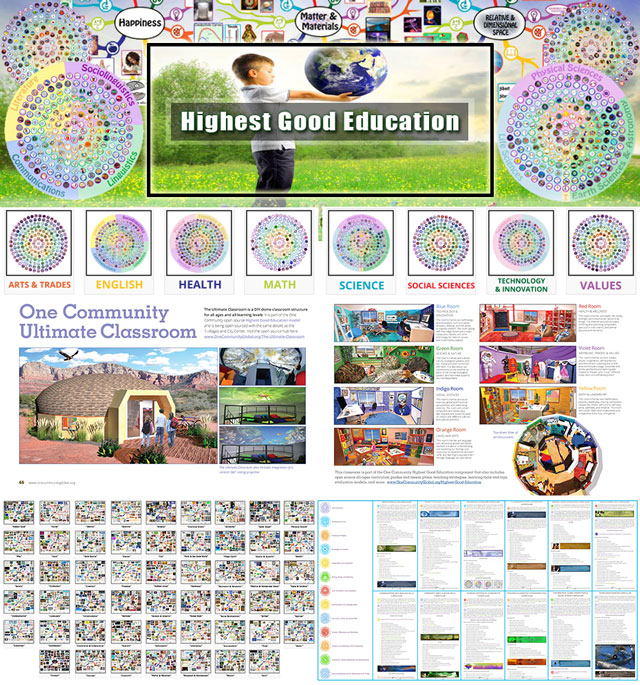
Maximizing Sustainable Impact – Highest Good Education: All Subjects | All Learning Levels | Any Age
MAXIMIZING SUSTAINABLE IMPACT – HIGHEST GOOD SOCIETY PROGRESS
 One Community is maximizing sustainable impact through a Highest Good society approach to living that is founded on fulfilled living, the study of meeting human needs, Community, and making a difference in the world:
One Community is maximizing sustainable impact through a Highest Good society approach to living that is founded on fulfilled living, the study of meeting human needs, Community, and making a difference in the world:
- Read the Highest Good society overview: Highest Good Society
- Learn about the model for fulfilled living and sharing: A Day in the Life
- Learn about the 4 economic models: RBE | For-profit | Non-profit | Entrepreneurship
- Learn about our open source community collaboration and management software: The Highest Good Network
This week, the core team completed 72 hours managing One Community volunteer-work review not included above, emails, social media accounts, web development, new bug identification and bug-fix integration for the Highest Good Network software, and interviewing and getting set up new volunteer team members. The pictures below show some of this work.
And another core team member contributed to One Community this week by reviewing Parts 2 and 3 of the Paul Wheaton’s podcast, Struggling With Big Spend. This is a panel discussion led by Paul Wheaton along with a few other panelists, including Jae.
The main topic revolves around a discussion of how to spend 500K while simultaneously affecting positive global change and bringing money back to our project via a perpetual motion machine. Brief notations were made on Google. He then began listening to an Eckhart Tolle audio recording “A New Earth”. View some of this work in the collage below.
Harsha Kulkarni (Data Analyst) continued working on One Community’s Google AdWords campaigns and Analytics details. This week, Harsha focused on enhancing the ad strength of multiple ads within the Open and Donating ad campaigns. She achieved this by adding relevant headlines and descriptions to the ads.
Her strategy included modifying existing content to generate more responsive ads. As a result, Harsha elevated seven ads to an average ad strength and three to a good level within the donation campaign. In the open-source campaign, she accomplished the ad strength goals with one ad reaching an excellent level, six ads achieving an average ad strength, and three ads attaining a good ad strength level.
The image below shows some of this work.
Vishvesh Sheora (Artificial Intelligence Specialist) focused on elevating the SEO performance of a multitude of blog posts featured on the One Community website. This week, Vishvesh was set to improve the SEO performance of articles. He pursued the objective of elevating their SEO scores by adhering to RankMath’s stipulated criteria, an influential SEO plugin.
Moreover, Vishvesh continued to expand and refine the tutorial draft, offering guidance on the effective utilization of RankMath for superior SEO results. He carefully curated content, incorporated RankMath’s tools and functionalities, and concurrently enhanced his knowledge of the plugin, solidifying his expertise in the field. See the work in the image below.
MAXIMIZING SUSTAINABLE IMPACT – ADMINISTRATION TEAM
This week, the Administration Team’s summary, covering their work administrating and managing most of One Community, was managed by Jamie Cruz (Administrative Assistant, Social Media Manager, and Team Manager) and includes Alyx Parr (Senior Support Specialist), Olawunmi “Ola” Ijisesan (Administrative and Management Support), Ruiqi Liu (Administrative Assistant), Shaurya Sareen (Administrative Assistant), and Xiaolai Li (Administrative Assistant).
Alyx focused on summarizing and providing comments on Google Docs for the blog, downloading images, and duplicating summaries to contribute to the blog’s content. She also did work on preparing summaries and downloading media, for her assigned portion of the blog.
She followed up with relevant individuals to ensure seamless collaboration and rectified any issues with the summaries on their page for the blog. Meanwhile, Jamie’s efforts revolved around the creation of video tutorials and the editing of her weekly page. She actively managed and coordinated the activities of the administration team, Blue Steel team, core team, and individual contributors.
She worked on organizing summaries, generating team summaries, and creating collages. Ola focused on non-HGN tasks, including reviewing and updating weekly folders and creating collages for the One Community blog. She played a key role in assisting the PR team, overseeing the review process to ensure that all summaries and images adhered to the feedback provided by the PRs.
Ola actively engaged with the reviewed work, confirmed the accuracy of reported PR numbers and offered comments and suggestions to enhance the team’s performance on their weekly tasks.
Ruiqi achieved significant progress by completing the four-step review process for the Funding Team, Blue Steel Team, and Expresser Team, providing feedback to all team members, and ensuring the creation of collage images stored in Dropbox and added to the media library on WordPress.
She effectively utilized weekly summaries to generate SEO keywords and incorporated them as Alt Titles on WordPress. Additionally, Ruiqi revised the weekly progress update webpage, ensuring accuracy and fixing any content issues. She also assisted other administrative assistants in checking web content and created a PDF with revision suggestions.
Shaurya did a review of all pull requests (PRs), addressing issues with team members who had omitted crucial steps in their work. He updated the tracking sheet and weekly table to include newly onboarded members of the Highest Good Network team, ensuring compliance with required PRs and hours. Shaurya skillfully crafted a concise team summary and compiled a team collage featuring all PRs.
Lastly, Xiaolai completed collages for three teams, organized the weekly report 552, and made necessary comments on team members’ work. After receiving feedback, he adjusted and updated the reports, checked summaries, and prepared images. Xiaolai also reviewed the final PDF for accuracy, transferred the work to his page, and planned to enhance tables and charts in the One Community Business Plan.
He collected and organized weekly summaries, pictures, and documents for weekly report #553 and uploaded the reports. The collage below shows some of this work.
MAXIMIZING SUSTAINABLE IMPACT – BLUE STEEL SOFTWARE DEVELOPMENT TEAM
This week, the Blue Steel Team’s summary, covering their work on the Highest Good Network software, was managed by Nathan Hoffman (Software Engineer) and includes Bada Kim (Full Stack Software Developer), Haohui Lin (Software Engineer), Kurtis Ivey (Full Stack Developer), Lucile Tronczyk (Full Stack Software Developer), Shree Birajdar (Software Developer), Xiao Wang (Software Engineer), and Yongjian Pan (React.js/MongoDB Full Stack Software Developer).
Yongjian persistently tackled the challenges of addressing failed npm tests in PR #842 and PR #1331, demonstrating a commitment to codebase integrity. Additionally, he delved into bug resolution for API call errors and console warnings, initiating a pull request to investigate non-existing projects and enhance user notifications.
Nathan’s week involved reviewing team summaries, creating PR 1420, helping Luis with permissions, and collaborating on reorganizing the permission spreadsheet. Kurtis investigated a front-end crashing issue and reviewed substantial PRs.
Haohui engaged in thorough reviews of Frontend PR#1277, 1390, 1359, and Backend PR#530, 556, and 562, contributing to project advancement. Shree introduced significant improvements to the Blue Square scheduler, streamlining user interactions and enhancing efficiency.
Lucile worked on quality assurance, testing pull requests, assessing bug reports, and participating in community activities, along with improving her Jest skills. The collage below shows some of this work.

Maximizing Sustainable Impact ” Blue Steel Team – Highest Good Network Software
MAXIMIZING SUSTAINABLE IMPACT – EXPRESSERS SOFTWARE DEVELOPMENT TEAM
This week, the Expressers Team’s summary, covering their work on the Highest Good Network software, was managed by Tim Kent (Full Stack Software Engineer) and includes Aaron Persaud (Software Developer), Olga Yudkin (Software Engineer), Tianyuan Nan (Software Engineer), Vishala Ramasamy (Software Developer) and Yuri Clemente Andrade Sokolovicz (Software Engineer and Team Manager).
Vishala began work on Phase 2, concentrating on the Log Material feature, encompassing both frontend and backend aspects, with a focus on enhancing user-friendliness. Yuri completed the UI design for the Tool Equipment List component, marking a significant milestone in HGN Phase 2 development.
Tianyuan carried out five PR reviews, addressing change requests and delving into bug resolution related to email list visibility. Olga worked on tests and project view component refactoring. Aaron played a pivotal role in fixing a security vulnerability, conducting extensive testing, and addressing critical issues.
And Tim managed team activities, lead standup meetings, and updated project task sheets while also addressing pull request change requests and initiating work on Node/Express backend API routing for Project Summaries page development. The collage below shows some of this work.
MAXIMIZING SUSTAINABLE IMPACT – FUNDING TEAM
This week, the Funding Team’s summary, covering their work for One Community Funding, was managed by Aaron Wang (Fundraising Assistant). Aaron sent emails to six prospective funders, and he did research on six additional potential funders, assessing their backgrounds, philosophy, funding track records, potential to secure funds and contact information.
Additionally, he obtained the contact information for two organizations. The collage below shows some of this work.
MAXIMIZING SUSTAINABLE IMPACT – GIT-R-DONE SOFTWARE DEVELOPMENT TEAM
This week, the Git-R-Done Team’s summary, covering their work on the Highest Good Network software, was managed by Ruiqi (Administrative Assistant) and includes Eduardo Horta (Software Engineer), Jeffrey Li (Full-Stack Software Developer), and Olena Danykh (Software Engineer).
Eduardo worked on HGN Software Development, overseeing GitHub pull requests, unit testing, team coordination, and documentation reviews. He reviewed and commented on two pull requests, facilitated discussions to prevent work overlaps, and initiated Phase 2 development talks.
Eduardo also began unit testing for the CopyToClipboard component, selected new team members, and helped with team cohesion. Jeffrey focused on code reviews and addressed development issues, resolving unintended access to Volunteer accounts during code review and tackling a team member display problem.
Olena reviewed the Bug Google document, testing multiple reported issues to identify one that aligns with their interests and expertise. She also did a review of the HGN Phase I Bugs and Needed Functionalities document. The collage below shows some of this work.
MAXIMIZING SUSTAINABLE IMPACT – GRAPHIC DESIGN TEAM
This week, the Graphic Design Team’s summary was managed by Ruiqi (Administrative Assistant) and includes Ashlesha Navale (Graphic Designer), Nancy Mónchez (Graphic Designer), Rihab Baklouti (Freelance Generalist), and Shivangi Patel (Graphic Designer). Ashlesha worked on two Volunteer Announcements, creating bio and announcement images, as well as web content.
She also produced five Social Media Images and researched nature-based and theme-based images for them. Nancy focused on implementing requested adjustments and changes in each post, with a particular focus on using various fonts. She also worked on reducing the use of project images to achieve a more comprehensive design that integrated elements such as animals, plants, and humans.
Rihab created three Volunteer Announcements, updated webpages, and designed images and YouTube previews. She also began a web page design for the Transition Menu project, attending meetings to collaborate with graphic designer Shivangi and create a mockup.
Shivangi produced two Volunteer Announcements and worked on the UI design for the recipe build-out tool homepage in collaboration with fellow designers, ensuring a user-friendly interface. The collage below shows some of this work.
MAXIMIZING SUSTAINABLE IMPACT – MOONFALL’S SOFTWARE DEVELOPMENT TEAM
This week, Moonfall Team’s summary, covering their work on the Highest Good Network software, was managed by Navneeth Krishna (Software Engineer) and includes Abdelmounaim “Abdel” Lallouache (Software Developer), Cheng-Yun Chuang (Software Engineer), Haoji Bian (Software Engineer), Jiadong Zhang (Volunteer Software Engineer), Tzu Ning “Leo” Chueh (Software Engineer), Xiao Fei (Software Engineer), Yihan Liu (Software Engineer), YuFu Liao (Software Engineer), Zijie “Cyril” Yu (Volunteer Software Engineer) and Zubing Guo (Software Engineer).
Abdelmounaim resolved the issue where the admin encountered difficulties updating user profiles created through the setup user feature. Cheng-Yun did a review 12 pull requests spanning across both backend and frontend repositories with a particular emphasis on frontend pull requests.
Jiadong transplanted the refactored components into the existing timelog module and abstracted text content into constants, enhancing code clarity. Haoji developed a new feature in the backend of the application that underwent significant enhancements, primarily focusing on fetching user profile images from specified websites.
Navneeth reviewed a bug related to the task “Permissions Mngmnt: See Teams Management Tab (Create Teams and edit team members only).” and began work on a new task by understanding the requirements from the Phase I Bugs document. Tzu Ning reviewed the implementation of the copy button for weekly summaries and user profiles ensuring users could copy summaries directly to the clipboard.
Xiao began by examining the codebase to identify the root of the issue concerning the ability for owner users to approve and apply ‘suggested’ changes on a task. Yihan focused on two previous pull requests, enhancing the frontend by updating the team code regex check rule and introducing a validator for regex as well as implementing authorization in the backend.
Yufu concentrated on making columns editable by Owner on the User Management Page and developed an adept solution involving a popup component. Zijie primarily focused on lint fixing the src/reducer directory, which contained 41 JS files. And Zubing integrated the ‘Write it for me’ button into the summary page, aligning with the development team’s objectives.
Look below for a collage of their work.
MAXIMIZING SUSTAINABLE IMPACT – REACTONAUTS’ SOFTWARE DEVELOPMENT TEAM
This week, Reactonauts’ Team’s summary, covering their work on the Highest Good Network software, was managed by Carl Bebl (Software Developer) and includes Anirudh Ghildiyal (Software Engineer), Jiangwei Shi (Full Stack Engineer), Jiyuan Xia (Software Engineer), Masasa Thapelo (Software Engineer), Obeda Velonjatovo (Front End Developer/Software Developer), Ramya Ramasamy (Full Stack Developer), Shantanu Kumar (Full Stack Software Developer), Shihao Xiong (Software Engineer), Shivansh Sharma (Software Developer), Shiwani Rajagopalan (Software Engineer), Shrey Jain (Software Engineer), Shubhankar Mishra (Software Engineer), Vansh Patel (Software Engineer), Vikram Badhan (Software Engineer), Wanting Xu (Software Engineer), Yixiao Jiang (Software Engineer) and Zuhang Xu (Software Engineer).
Anirudh worked on addressing the badge component task and resolved the problem with the edit button. Carl resolved the absence of suggestion options in the production environment, actively engaging in peer reviews and implementing suggested improvements.
Jiangwei addressed the pending questions from the previous week’s PR and took a hands-on approach by implementing a test for TeamTable.test.js. Jiyuan completed 5 PR reviews, addressing critical aspects of the codebase. He also did a a detailed review of PR #1390. Masasa managed and resolved merge conflicts and aligned the permission list with their respective descriptions.
Obeda resolved a failing check in his PR related to Node.js CI/build (14.x) caused by a change in the permission.js file, performed a lint fix on the AutoUpdate component and submitted a PR for it. Ramya raised front and back-end PRs for the Limit-See-All functionality, actively addressed feedback, and worked on lint fixes for the Summary Bar component.
Shantanu discovered new findings related to the button functionality. Shihao reviewed multiple PRs, monitored the progress of others, and prepared for an upcoming unit test. Shivansh did an investigation into the current Node.js version within the production environment, tracking the logs of GitHub actions to gather relevant data.
Shiwani worked on configuring permissions for total valid weekly summaries, adding them to the user management page and addressing an issue related to edit access. She also tackled linting issues in the constants folder and submitted a pull request.
Shrey focused on rectifying the “add team members” functionality within the HighestGoodNetwork project, addressing display and code optimization issues, and actively engaging with the team for resolutions and reviews.
Shubhankar concentrated on establishing the work environment and addressing errors from preceding weeks, he approved several PRs without any complications and also identified and assisted in the merging of certain reviewed PRs. Vansh resumed work on implementing reminders for weekly summaries and reviewed PRs following a temporary hiatus.
Vikram focused on setting up the frontend and backend environment locally and completed reviews for 5 pull requests. Wanting primarily focused on the development task titled “Make 5-letter codes editable only by Admin and Owner Class,” raising PR #1434 for review and contributing to the review of PRs #1411, #1418, and #1428.
Yixiao reviewed two pull requests (PRs) numbered 1429 and 1439 and focused on writing unit tests, particularly for the Checkbox.js file. And Zuhang examined feedback from prior pull request evaluations, tackled existing problems and sought ways to improve the overall project. Look below for pictures of this work.

Maximizing Sustainable Impact ” Reactonauts Team – Highest Good Network software
MAXIMIZING SUSTAINABLE IMPACT – SKYE’S SOFTWARE DEVELOPMENT TEAM
This week, skye’s summary, covering their work on the Highest Good Network software, was managed by Luis Arevalo (Front End Developer) and includes Bailey Mejia (Software Engineer), Jerry Ren (Full Stack Developer), Mounica Dingari (Software Developer) and Yao Wang (Software Engineer).
Bailey focused on addressing the issue with the new personal max badge bug. He duplicated the badge and identified the checkPersonalMax function as the culprit, resolving the issue by adding logs and thorough testing. Jerry reviewed the frontend PR #1282 and adjusted the ‘Create Dev Admin account email verification system’ task.
He removed a redundant ‘is-email-exists’ route and implemented conditional rendering of input fields for ‘Actual Email’ and ‘Actual Password’ based on user role selection. He also added form error handling for accurate error messages. Luis completed the user profile’s weekly summary intro button.
He implemented the use of the ‘getProjectMembers’ permission, ensuring that the button appears only for Admins, Managers, and Owners who possess this permission. Additionally, Luis addressed a bug that caused crashes when a user wasn’t part of a team by implementing a check to verify the user’s team membership as a requirement for button visibility.
Mounica completed testing on PR#1435, focusing on lint fixes for the Constants folder in src/constants/*. She also examined PR#1434, PR#1432 and PR#1413. And Yao continued to address the persistent bug that hinders tasks from reaching the “submit for review” status. He executed thorough testing on PR #1282, confirming the absence of any discernible issues within the pull request.
See the collage below for their work.
MAXIMIZING SUSTAINABLE IMPACT – SOFTWARE PR REVIEW TEAM
The PR Review Team’s summary covering their work on the Highest Good Network software, was managed by Shaurya Sareen (Administrative Assistant).
This week’s active members of this team were: Anish Pandita (Software Engineer), Chirayu Rai (Software Engineer), Jahanzaib Malik (Software Engineer), John Ifeanyi Omeokwe (Software Engineer), Kaikane Lacno (Software Engineer), Miguelcloid Reniva (Software Developer), Mike ” Munkh Erdene Erdenebulgan (Full Stack Developer), Palak Gosalia (Software Engineer), Rhea Wu (Software Engineer), Ruike Qiu (Software Engineer), Savio Mendes (Software Engineer), Shubhankar V (Software Engineer), Yi Lin (Software Engineer), and Ziming Song (Software Engineer).
They reviewed all the Highest Good Network PRs (Pull Requests) shared in this week’s update. The collage below shows a compilation of the work from this team.
AND WE PRODUCED THIS WEEKLY UPDATES BLOG – CLICK HERE TO SUBSCRIBE
FOLLOW ONE COMMUNITY’S PROGRESS (click icons for our pages)
INVESTOR PAGES
GET INVOLVED
One Community Welcomes Navneeth Krishna to the Software Development Team!
Posted on October 20, 2023 by One Community Hs
One Community welcomes Navneeth Krishna to the Software Development Team as our newest Volunteer/Consultant!

Navneeth is an enthusiastic problem solver, ML Researcher, and Adventurer with an M.S. in Computer Engineering from NYU Tandon School of Engineering and a year of professional software engineering experience. He is a collaborative team player who thrives in leadership roles and is always looking for opportunities to grow and learn. He has demonstrated excellence in fast-paced environments, reliable software delivery, and team management. Navneeth has experience in full-stack development with modern front-end frameworks, REST API architectures, database schemas, web scraping, and algorithm design & implementation. As a member of One Community, he has worked on the implementation of permissions-based UI rendering and backend processing within the Highest Good Network software. He also works on managing a team of Software Engineers as a Software Team Manager. You can explore more of Navneeth’s work and journey on his GitHub and Portfolio.
WELCOME TO THE TEAM NAVNEETH!
FOLLOW ONE COMMUNITY’S PROGRESS (click icons for our pages)
INVESTOR PAGES
GET INVOLVED
One Community Welcomes Luis Arevalo to the Software Development Team!
Posted on October 20, 2023 by One Community Hs
One Community welcomes Luis Arevalo to the Software Development Team as our newest Volunteer/Consultant!

Luis possesses more than two years of software development expertise, spanning various web applications. His track record shines through as he excels in dynamic work settings and thrives on intricate projects, consistently delivering efficient and effective solutions to intricate challenges. His commitment to resource optimization, achieving more with less, and advocating for sustainability in both resource and infrastructure utilization underscores his dedication to making a positive impact on the environment and the economy. As part of the One Community team, Luis is a Highest Good Network software team manager and has helped with debugging and creation of copy-to-clipboard functionalities that help with weekly managerial duties.
WELCOME TO THE TEAM LUIS!
FOLLOW ONE COMMUNITY’S PROGRESS (click icons for our pages)
INVESTOR PAGES
GET INVOLVED
One Community Welcomes Jiyuan Xia to the Software Development Team!
Posted on October 20, 2023 by One Community Hs
One Community welcomes Jiyuan Xia to the Software Development Team as our newest Volunteer/Consultant!
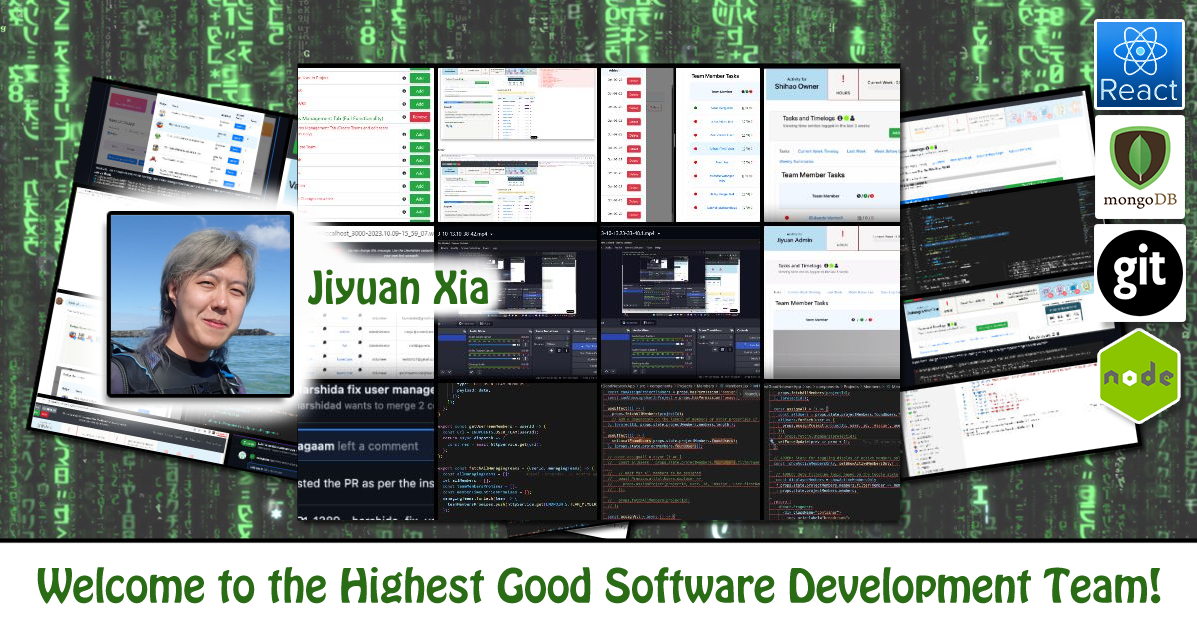
Jiyuan recently completed a master’s degree in computer science, specializing in web development and full-stack technologies. He has actively contributed to the One Community Highest Good Network software team by assisting in the review of numerous pull requests and addressing system bugs, showcasing his dedication to delivering robust and high-quality software solutions. In his recent work, Jiyuan has been instrumental in enhancing system stability and improving code quality, making a positive impact on the team’s software development efforts.
WELCOME TO THE TEAM JIYUAN!
FOLLOW ONE COMMUNITY’S PROGRESS (click icons for our pages)
INVESTOR PAGES
GET INVOLVED
One Community Welcomes Shivansh Sharma to the Software Development Team!
Posted on October 20, 2023 by One Community Hs
One Community welcomes Shivansh Sharma to the Software Development Team as our newest Volunteer/Consultant!
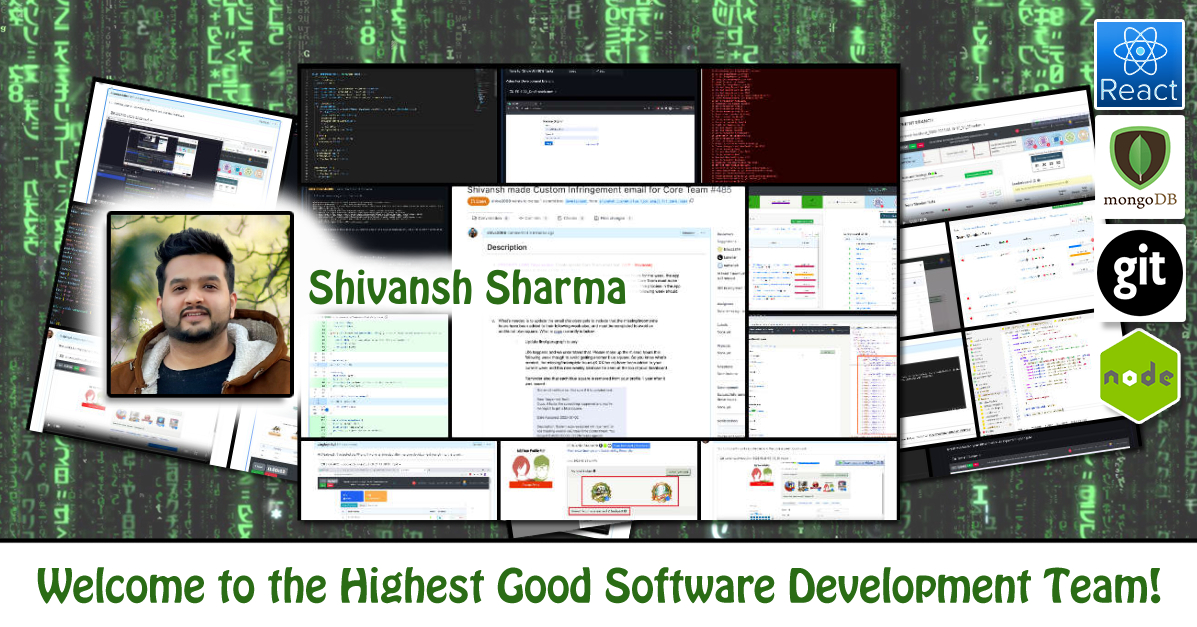
Shivansh is a seasoned Software Engineer (SWE) who boasts a rich background of over three years in the field, during which he has been involved in a diverse range of projects. His track record reflects his prowess in thriving within high-speed work environments and tackling intricate assignments by providing resourceful and pragmatic solutions to demanding problems. Shivansh is a firm advocate of resource efficiency, the philosophy of achieving more with less, and he actively contributes to the promotion of sustainability in both resources and infrastructure. He sees this approach as a means to make a positive impact on the environment while simultaneously benefiting the economy. As a member of the One Community team, Shivansh has helped in developing new functionalities, resolving critical bugs, and upgrading the code for our open-source Highest Good Network Software.
WELCOME TO THE TEAM SHIVANSH!
FOLLOW ONE COMMUNITY’S PROGRESS (click icons for our pages)
 One Community
One Community